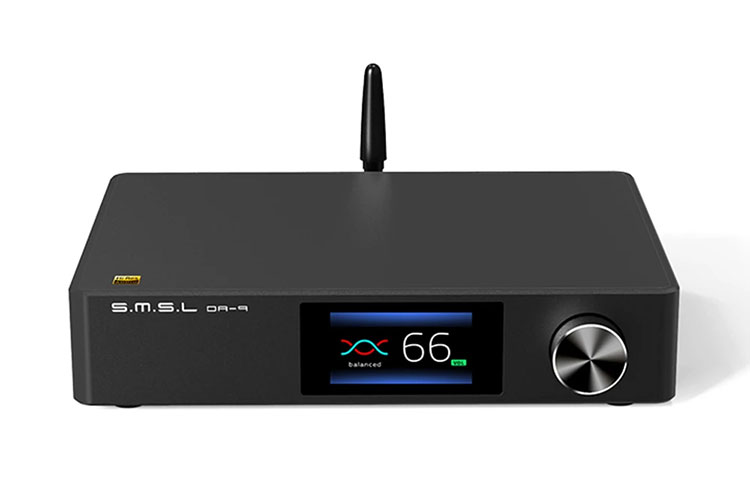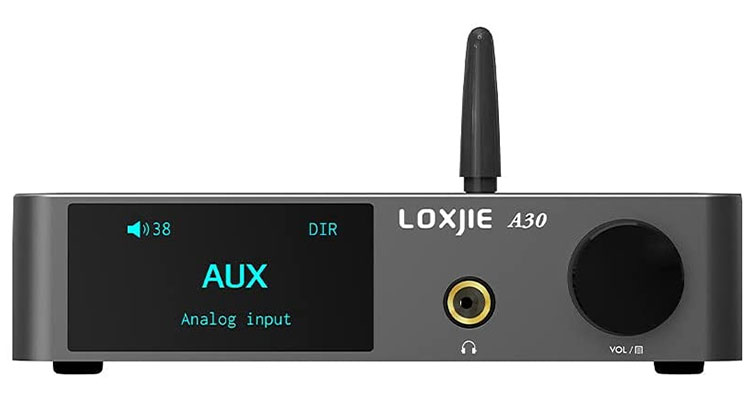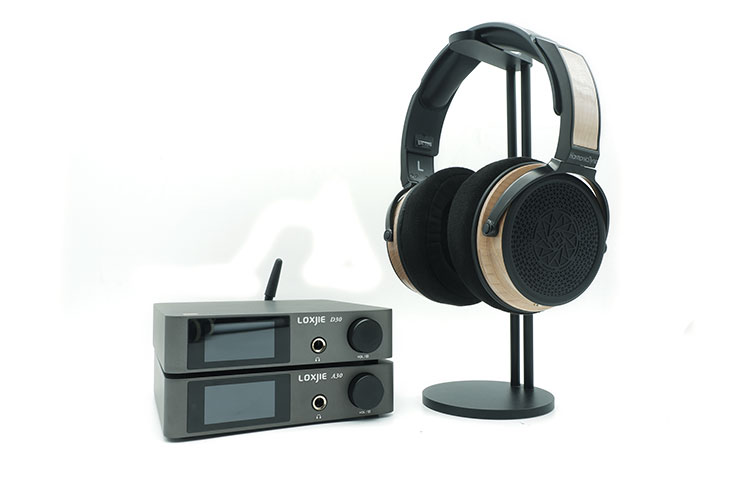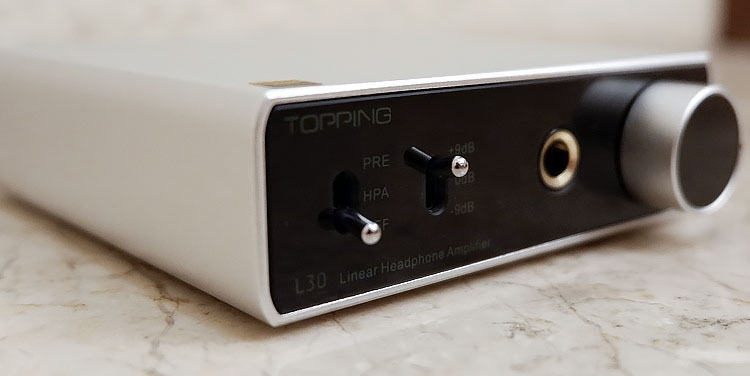Synergy
Power
As a speaker amplifier, the A30 plays substantially loud, with the 2 speakers that I tested, the A30 easily drove them to ear-splitting levels. Connected to my Wharfedale Diamond 9.4, the D30 only needed to be cranked up to 25 to reach my comfortable listening levels. With my Monitor Audio Monitor 100 speaker, I needed around 30 to reach my comfortable listening levels.
While the specs sheet on the A30 lists the headphone amplifier section on the A30 to be 100mW into 32Ω, I’m surprised that it can easily power all the headphones that I tried with it.
I tried my Sennheiser HD600, which is a high impedance headphone, and I only needed around 35 to reach my maximum comfortable listening levels. With planar magnetic headphones like the Hifiman Ananda, on the other hand, I only needed to crank it up to 18.
On the flip side, the A30 is also quiet enough to power more sensitive IEMs without creating an audible hiss while maintaining volume tracking throughout the volume range. So IEMs like the FiiO FD3 or the Mangird MT4 can be powered off of the A30.
Pairings
When it comes to speaker pairings, the more energetic nature of the A30 has to be taken into account. My go-to pairing for class D amplifiers is my Wharfedale Diamond 9.4, but surprisingly it didn’t pan out the way I hoped it would. The warmer character of the 9.4 doubled down on the warmer bass character on the A30, which resulted in having an overpowering bass response.
Moving over to my Monitor Audio Monitor 100 bookshelf speakers, which have a colder and more subdued character, the pairing with the A30 ends up being simply synergistic. The faster nature of the A30 allowed the Monitor 100 to maintain its clarity and speed while being imbued with a bit more warmth and energy making this pairing a truly engaging listen.
Similarly, the A30 also pairs well with headphones that are not overly energetic, so something like the HarmonicDyne Poseidon made for a synergistic pairing. This makes the pairing more exciting while maintaining the immediate sense of attack on the Poseidon.
While all these pairings worked well with the A30, there is a marked improvement when the internal DAC or Bluetooth receiver on the A30 is bypassed in favor of an external DAC.
Feeding Loxjie’s own D30 DAC into the A30 allows it to simply focus on being an amplifier, bringing up the signal chain into a whole new level of clarity allowing nuances in the music to be more present while the soundstage is more layered and separated.

Select Comparisons
SMSL DA-9
$249.99
Technical
As speaker amplifiers, both the DA-9 and the A30 use the same internal class D amplifier with both of them being equipped with Infineon 12070 chips, they also have the same NJW1194 volume controller.
However, the DA-9 has a full balanced input option, thus it also has a completely balanced internal circuit. The power output of both units is similar though, with the DA-9 putting out 10W more at 90W into 4Ω.
Both amplifiers also have internal DAC chips, but the one on the DA-9 is strictly used for Bluetooth, as there are no other input options for the DAC. Furthermore, the DA-9 also doesn’t have a headphone output section, so the DA-9 is strictly a balanced integrated amplifier with Bluetooth functionality.
Design
The footprint of the DA-9 is much larger, but the power supply on the DA-9 is internal. Having a power supply inside the DA-9 also makes it feel more substantial.
Having a standard IEC power cord also makes it more convenient for use with some audiophile-grade power cables. However, having an external power supply on the A30 also allows for the option of upgrading the entire power supply down the road.
Despite having a larger footprint while having fewer input options, the DA-9 still ends having an equally crowded speaker terminal section.
The front of both devices is similar as well, both having a colored screen in front, while the menu navigation and available menu options are also similar. Aside from standard tone controls, the DA-9 has an option for SDB which works like a loudness button that follows the Fletcher-Munsen curve.
Both devices also have remote controls, so controlling them from the couch is equally convenient. The DA-9 can also end up having a busier menu system, since there are backgrounds that look nice, but may become a hindrance when viewing it from a distance.
Performance
Having similar internals, I figured that these 2 amplifiers should sound similar, however, the other components like the internal DAC, and the power supply still play a role.
With the DA-9, there is a notably flatter tonal balance, making music sound a bit colder and overall less energetic. This can make the DA-9 pair well with some of the warmer speakers like the Wharfedale Diamond 9.4.
While the bass on the DA-9 is flatter overall, the detail retrieval and the attack are equal on both amplifiers. The midrange on the other hand ends up being more forward on the DA-9, but less euphonic overall.
The treble on the other hand has a more subdued character with the DA-9, ensuring that cymbal hits won’t be too energetic.
However, more neutral speakers like the Monitor Audio Monitor 100 end up being too neutral to pair with the already neutral DA-9, in contrast to the more enjoyable pairing with the A30. With the less energetic nature of the DA-9 though, it can be perceived to have a better sense of contrast in its dynamic range.
Soundstage isn’t exactly the strong suit of either amplifier, however, the DA-9 has an overall flatter soundstage. So the layering within the soundstage sounds more compressed comparatively. However, the accuracy of the directionality of the images within the soundstage is presented equally well.
Topping L30
$139
Technical
In terms of features, the L30 is more stripped-down, since it’s strictly a headphone amplifier with single-ended inputs and outputs. The only extra feature that it has is switchable pre-amp outputs at the rear, however, it doesn’t have any built-in DAC or speaker outputs.
Internally, the L30 is based on Topping’s NFCA amplifier topology, and it promises diminishingly low THD numbers, with the THD+N on the L30, in particular, being measured at 0.00007%.
Based on the specs sheet, the L30’s headphone section has a lot more power to spare having a rated output of 2.3W into 32Ω. However, I wouldn’t dismiss either amplifier simply based on rated power output numbers.
While the L30 has lots of power on tap, the volume control doesn’t become a big concern with it since it has 3 gain levels. This ensures that the potentiometer would have accurate tracking at all times because it could be placed at approximately the middle of the volume range.
Design
Despite having much higher rated power outputs, the L30 is in a much smaller aluminum chassis. It does require an external power transformer which is a lot heavier than a switch-mode power supply.
Being stripped down also continues when it comes to the design on the L30 since it doesn’t have any screen or any menu system. Instead, it relies on classic toggle switches to access the different functions that are available to it. What both amplifiers share in common though is that both of them have a ¼” headphone output in front.
At the rear, the L30 is again very simple, with just 2 RCA jacks for the inputs, and 2 RCA jacks for the pre-amp outputs. Next to the RCA jacks, there is a round power input that accepts 15V AC, so it should be noted that the power supply on the L30 will be harder to come by since it’s an AC transformer instead of a switch-mode power supply.
Performance
The disparity in power numbers between the 2 amplifiers may make any meaningful comparison unfair. However, when powering most of my headphones, both amplifiers can easily drive most of my headphones, including planar magnetic headphones like the Hifiman Ananda.
I initially noted that the L30 has more bass quantity while having the same amount of nuance and texture. However, it added more weight to the bass while losing out on the speed of the attack resulting in a more sluggish presentation comparatively.
Although both amplifiers have a slightly V-shaped presentation, the softer quality of the L30 ends up making the vocalists less distinct. Although the nuance in the vocals can still be heard with both amplifiers, the L30 smooths over the leading edges of notes making them more blunted comparatively.
Similarly, instrument quality is flowier with the L30 which makes instruments like violins and cellos sound more natural. However, guitar plucks or distinct keystrokes on a piano are more glossed over, losing that singular quality of the note, particularly with busier passages.
Treble instruments on the other hand have a more splashy quality on the L30, allowing cymbal hits to permeate throughout the soundscape. However, the crystalline quality of cymbal hits and the edginess of wind instruments are comparatively more glossed over.
What surprised me the most in this comparison is when I started to listen to orchestral recordings. While the soundstage is expansive on both amplifiers, the images that are formed with the L30 are formed closer in while the size of the images formed with the L30 is smaller.
The directionality of the images is equally accurate on both amplifiers, however, the images with the L30 are less chiseled and delineated.
Our Verdict
Taking one look at the A30 itself and the specs sheet that comes with it, I would typically dismiss it as too good to be true. I was fortunate, however, to have the opportunity to take a closer look at it, and I’m happy to learn that both the size and the rated power outputs are more than meets the eye.
Although the A30 is a fully capable integrated amplifier, the most striking feature of the A30 is the amplifier section for both speakers and headphones. With speakers, the A30 may be a bit warmer than most class-D amplifiers, but creates a truly engaging experience with more neutral speakers.
With headphones, on the other hand, the 100mW power rating surprised me, and it proves to me that it’s the quality of those watts that matters.
It easily pairs with many headphones, allowing the quality of the headphones to shine through while maintaining control over the drivers creating a detailed listening experience with images that are properly placed within the soundscape.
Loxjie A30 Technical Specifications
- Input: USB, Optical, Coaxial, Analog(RCA), Bluetooth
- Output: 35mm headphone, speaker
- THD+N(A-weighted): 003%
- SNR(A-weighted): 108dB
- Output power: Amplifier 80Wx2(4Ω), 40Wx2(8Ω)/ Headphone amplifier 100mW(32Ω)
- Power Consumption: 35W(normal power amplifier volume)
- Standby Power: <0.5@
- Size: 151 x 170 x 38mm(WxHxD)
- Package Dimensions: 294 x 232 x 88mm(WxHxD)
- Weight: 520g





